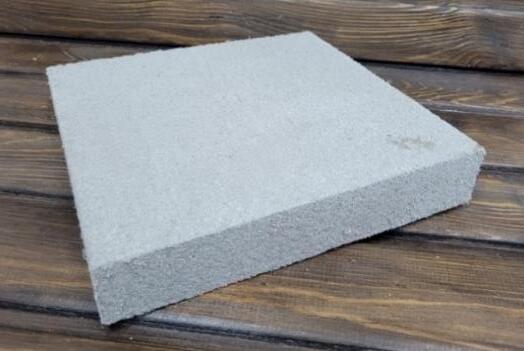
13 minute read
ACTA FACULTATIS XYLOLOGIAE
ZVOLEN, 65(1): 87 104, 2023
Zvolen, Technická univerzita vo Zvolene
Advertisement
DOI: 10.17423/afx.2023.65.1.08
DEEP IMPREGNATION OF BINDER-FREE, LOW-DENSITY WOOD BOARDS WITH FLAME RETARDANTS
Sergei Kazitsin - Aleksey Namyatov - Mikhail Bayandin - Nina Grotskaya
Abstract
This study is aimed at making binder-free low-density wood boards from mechanically activated sawdust by the process of deep vacuum-pressure timber impregnation with aqueous solutions of flame retardants. The thermal decomposition of impregnated boards was examined by thermogravimetric analysis (TGA). Determination of the maximum flame retardant absorption was carried out by a factorial experiment. The SEM/EDX method was used to estimate the distribution of flame retardants across the entire thickness of the board. The fire-proof efficiency of flame retardants was determined as specified in the GOST 12.1.044-89 standards. It was found that the deep impregnation of binder-free boards with a density of 290 kg/m3 makes it possible to obtain a low-combustible material.
Keywords: low-density boards, sawdust, structure of boards, electron microscopy, hydrodynamic processing, fire retardant, wood modification.
Introduction
Wood-based materials play an important role in the transition to a closed-loop economy. Boards made from renewable, plant-based materials are of particular interest. They reduce the environmental impact, save resources, and significantly contribute to reducing CO2 emissions (De Luca et al., 2017). In this regard, sawmill and woodworking waste (sawdust, wood chips, and lumps) are highly promising. So far, they have been mainly used to make wood-based panels and provide heat.
The construction industry needs environment-friendly, safe, high-performance materials. Low thermal conductivity, soundproofing, shape stability when exposed to moisture, structural strength, etc., are expected. Currently, low-density wood boards are extensively studied (Monteiro et al., 2019, Pham Van et al., 2021, Sable et al., 2015). Monteiro S. et al. obtained chipboard using sour cassava starch as a binder. The properties of such panels are as follows. Density 405 kg/m3; tensile strength: 0.44 MPa; swelling in thickness: 13.2 %. The use of low-density kiri wood (Paulownia tomentosa) makes it possible to create oriented chipboard with a density of 400 kg/m3 and a tensile strength perpendicular to the board of 0.52 MPa (Pham Van et al., 2021). The authors Sable I. et al. obtained a wood-fiber material based on birch wood with a density of 102 to 120 kg/m3. The interest in such materials arises from the stringent building environmental safety and energy efficiency requirements (Abu-Jdayil et al., 2019).
Wood, with all its clear advantages, is flammable and combustible (Sheloumov,2017, Maksimenko et al., 2013). The paper lists the most common wood fire resistance enhancement methods: applying solutions to the wood particles or treatment of finished boards with a flame retardant by applying it to the surface (Leonovich, 2003). The introduction of flame retardants during the manufacturing process increases the fire resistance of wood boards making them low-combustible. However, it reduces the mechanical properties (Zhang et al., 2022, Selamat et al., 2018, Antonov et al., 2012, Ermolin et al., 2015). Zhang B. et al. state that adding fire retardants to wood particles for making 650 kg/m3 chipboard with isocyanate and MUF resin results in a tensile strength reduction from 0.81 MPa to 0.42 MPa and 0.36 MPa, and a thicker swelling: from 5.2 % to 15.1 % and 11.2 % (Dubrulle et al., 2020). Selamat M. E. notes that adding 10 % and 20 % of fire magnesium oxide as a fire retardant to 800 kg/m3 oil palm trunk chipboard decreases the tensile strength from 1.16 MPa to 0.62 MPa and 0.54 MPa, respectively.
The application of fire retardants to the surface of finished boards is intended to prevent flame propagation along the surface. However, the fire retardant is washed away when the board is exposed to a variable moisture environment. It decreases the board fire resistance even after a relatively short service life (Bahrani et al., 2018, Dubrulle et al., 2020). In addition, thelackofaflameretardant insidethematerial increases its flammability. Therefore, the search for ways of uniform fire protection of boards throughout the entire volume is an urgent task.
Deep impregnation is the most reliable method for solid wood fire protection. The flame retardant is applied through the entire material under overpressure in the autoclave (Ermolin, 1999, Bazhenov et al., 1953). However, the process is not used to protect woodbased composites (Wang et al., 2010). The binder adhesion to the wood chips creates the required physical and mechanical properties of the board, including its low thermal conductivity (Donaldson et al., 1989, Hubbe et al., 2018). As the number of adhesive contacts in wood boards is deficient, they fail under relatively low loads. The autoclave impregnation process uses overpressure or vacuuming. In both cases, mechanical stresses are created at the adhesive contacts between the chips resulting in a loss of strength or complete failure of the board (Panev,2018). Note that most flame retardants can destroy the supramolecular structures of the cured polymer binder and cause wood swelling. It can also lead to the destruction of adhesive contacts under relatively low external stress. This can be a serious disadvantage in variable humidity conditions (Chudinov,1984,Shvartsman,1997)
A possible solution is increasing the number of chip-to-chip contacts without using any synthetic binders. A team from Fraunhofer Institute for Wood Research, WilhelmKlauditz-Institut WKI, Braunschweig, developed a manufacturing technology for making a binder-free material called wood foam (Bunzel et al., 2017). They turn wood into thermomechanical pulp (TMP). A wood fiber pulp is foamed by a natural foam stabilizer (e.g., protein) and exposed to air during mixing. The material density ranges from 40 to 250 kg/m3. The 110 kg/m3 pinewood boards have a 0.205 MPa compressive strength and a 0.09 MPa tensile strength perpendicular to the board. The thermal conductivity coefficient of the boards of 0.038 W/(m K) is reached at about 40 kg/m3 (Bunzel et al., 2018).
Our earlier studies (Ermolin et al., 2020, Ermolin et al., 2019, Bayandin et al., 2021) showed that sawdust activated with the hydrodynamic method is suitable for making lowdensity wood boards without any binder, but with higher physical and mechanical properties and water resistance (Figure 1). The properties of such panels are as follows: density: 250 kg/m3; flexural strength: 1.26 MPa; tensile strength perpendicular to the board: 0.25 MPa; swelling in 24 h: does not exceed 5 %. After drying, the samples return to their initial dimensions and maintain up to 100% of the initial structural strength. The thermal conductivity of the boards at 8 % moisture content is 0.039 W/m∙K. Such boards are heat insulators (Namyatov,2018). The hydrodynamic treatment is based on cavitation. The wood particles are significantly transformed: the number of macro capillaries and the specific surface increase.
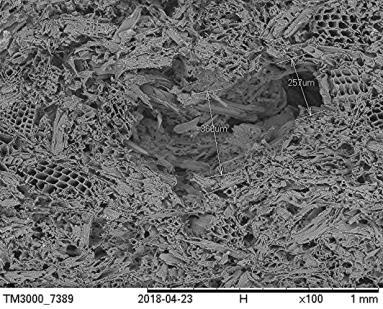
Excellent mechanical properties and water resistance make it possible to use deep impregnation flame retardants. The use of this method will ensure maximum absorption of the flame retardant and its even distribution. The purpose of this study is to assess the effect of deep impregnation with fire retardants of low-density, binder-free wood boards on their thermal resistance.
Material And Methods
Materials
We made the sample boards with coniferous sawdust (Pinus sylvestris, moisture content 83±12%) (Figure 2a), which was collected at the Krasles sawmill (Krasnoyarsk Territory, Russia). The fractional composition of sawdust is shown in Figure 2b. The particle size did not exceed 10 mm. They were separated by mechanical sorting method. (а) (b)
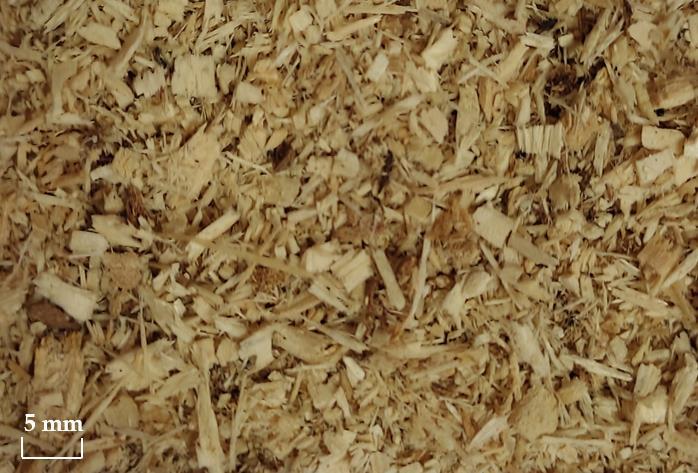
There are many fire retardants available. Analysis of prior information (Sheloumov, 2017, Kulakov et al., 2021, Sivenkov, 2015, Prokopenko, 2019, Kolesnikov et al., 2019) allowed us to identify the following inorganic flame retardant impregnating compounds for surface and deep impregnation, presented in Table 1 and Figure 3.
The key fire retardant selection criteria were:
• certified compliance with Group 1 Fire Retardance (in accordance with the GOST R 53292 standard)
• fire retardant as an aqueous solution
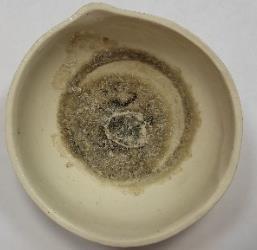
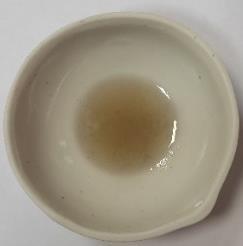
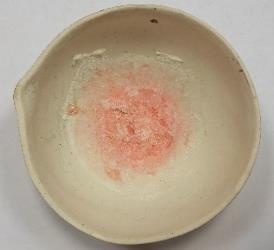
• suitability for the fire protection of wood and wood-based materials
• commercial availability.
Tab. 1 Fire retardant properties.
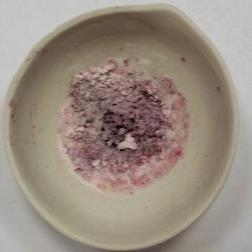
The impregnant substance concentration in terms of dry matter was 29.4±0.6%. These substances are extensively used for fireproofing of wood.
Manufacture of low density wood boards
The sawdust was collected at a sawmill. We mixed the sawdust with water at 8 to 10oC. The sawdust content in the mixture was 10% (Ermolin et al., 2017). A lab-grade rotary-pulse hydrodynamic homogenizer was used (Figure 4). After mixing sawdust with water, the apparatus was switched on and repeated mass processing was carried out by passing through the hydrodynamic homogenizer (3) (rotor and stator). The rotation frequency of the rotor was 2950 rev/min. The treatment lasted for 30 minutes.
A layer of the resulting wood pulp by pouring it into a metal mold with a 250x250 mm mesh bottom and the cell size 1 mm was formed. The molded layer was dewatered by cold pressing at 0.5 MPa. The moisture content of the mass after cold pressing was 200 ± 20%. Thenthelayerswereremovedfromthemoldandplacedinaconvectionairdryer.Thedrying temperature was 105±5 °C, and the air stream velocity was 2.5 m/s. After conditioning under normal conditions at 65% RH and 23oC for three days, the boards were processed by surface planer and thicknesser to form smooth parallel surfaces. The final size of the boards was [(250х250х30) ± 1] mm.
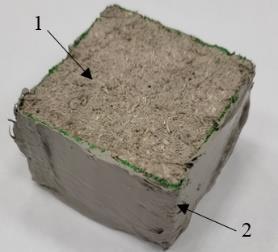
The final moisture content of the boards was 8.4 ± 0.1%. The density of the boards was determined as specified in the GOST 17177-94 standard. This is the ratio between the mass loss of a sample dried in a convection air dryer at (105 ± 5) °C to a constant mass, and themass ofthesampleafterdrying.Thesizeofthe samples was [(50×50×30)±1]mm.Three samples from the boards were used for each experiment. The board density as this moisture was 290±10 kg/m3 .
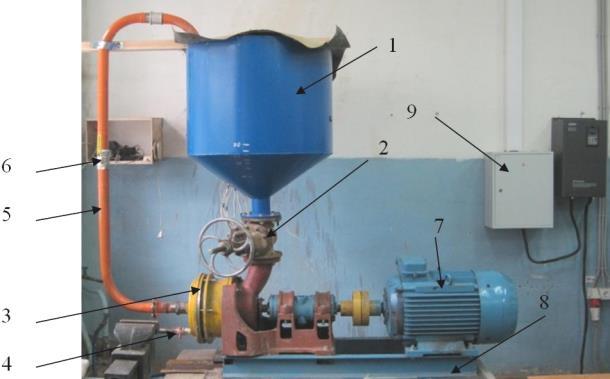
Deep impregnation of wood boards with flame retardants
Autoclaveimpregnation ofporousmaterialsensuresmaxabsorptionandanevendistribution oftheimpregnant. The absorption rate depends ontheproperties of the impregnatedmaterial and the impregnant, pressure, and duration of the impregnation (Krivonogov et al., 2018). The impregnation of wood boards was not previously studied. We performed experiments to determine the conditions for max absorption of the fire retardant. We used low-density board samples (40x40x30 mm, 8.2% humidity). The impregnated substance (composition 4) concentration in terms of dry matter was 27.4±2.5 %. To simulate the impregnation of industrial-size boards, the edges of the boards were insulated with a layer of PF-115 enamel and Akfix P635 sealant (Fig. 5).
The experiment followed the Box-Wilson experimental design (Taavitsainen, 2011). The independent variables were the vacuum hold period (t, min) and the underpressure (V, MPa). The board samples impregnated with water were used as a reference (Golubev et al,. 2020). The dependent variable was the total flame retardant absorption (P, kg/m3). The experimental impregnation process was as follows. The prepared samples were loaded into an autoclave (Fig. 6). The underpressure and hold periods are indicated in Table 2. Then, still under vacuum, the fire retardant was introduced, the pressure was raised to the atmospheric pressure, and the samples were held for 5 min. Then the fire retardant was removed from the sample surface with filter paper.
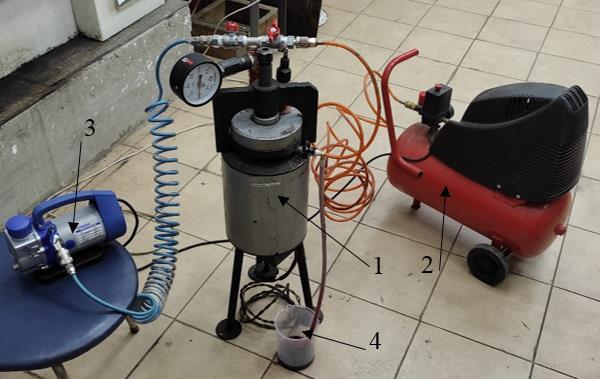
After impregnation, the samples were dried in a Binder ED 23 drying cabinet at 105 ± 5 oC. The boards were subsequently conditioned for three days in normal conditions. The total absorption of flame retardant composition was determined as specified in the GOST 20022.6-93 standard. Absorption P, kg/m3, was determined in accordance with equation where m1 - sample mass before impregnation, kg, m2 - sample mass after impregnation and drying, kg, V – volume of sample, m3 .
Thermogravimetrical analysis (TGA)
To determine the effects of flame retardants on the thermal decay of binder-free wood boards, we impregnated the samples by soaking them in the above-listed solutions. We used low-density board samples (40x40x30)±1 mm. Three samples were used for each experiment. For control, three samples were soaked with water. Since the permeability of this material has not yet been studied sufficiently, after a series of preliminary studies, we adopted the vacuum-atmospheric pressure impregnation method as the most productive. The prepared samples were loaded into an autoclave (Fig. 6) at t = 2 min, V=0.01MPa. Then, still under vacuum, the fire retardant was introduced, the pressure was raised to the atmospheric pressure, and the samples were held for 1 min. Then the fire retardant was removed from the sample surface with filter paper. The samples were then dried at room temperature until their mass did not change anymore. Fig. 7 shows the photos of the samples.
After conditioning under normal conditions at 65% RH and 23 oC for three days, the boards were examined by thermogravimetric analysis (TGA) (Azarov et al., 2010).
Thermal analysis was performed on samples weighing 13±0.1 mg taken from the central part of the samples impregnated with flame retardants. Three TGA samples were taken from each impregnated board. A TGA55 thermogravimetric analyzer from TA Instruments (USA) was used. The measurements were taken in an inert nitrogen atmosphere supplied at 45 ml/min in the 40 to 600 °C temperature range and a 20 °C/min heating rate. The TRIOS v. 5.00.44608 software processed the results.
Scanning electron microscopy (SEM) and energy dispersive X-ray spectroscopy (EDX) SEM/EDX microphotography with energy-dispersive X-ray spectroscopy (EDX) was used to study the distribution of fire retardant 4 across the bulk of the boards during impregnation. A Tabletop Microscope Hitachi TM4000Plus was used for microscopic studies. The board samples had a moisture content of 8.4 ± 0.1% and contained 103.8 ± 1.4 kg/m3 of fire retardant 4 on a dry matter basis. The dust-free sample was placed on a table (without additional sample preparation). During the image capturing process accelerating voltage of 15 kV and backscattered electron were used. Vacuum modes were "Conductor" and "Standard". Element mapping was carried out with an X-ray energy dispersion spectrometer BRUKER XFlash 630Hc coupled with a microscope. Accelerating voltage: 20kV.
Determination of fire-retardant efficiency
To determine the flammability, we used a ceramic box according to the GOST 12.1.044-89 standard (Fig. 8). We prepared three samples: 30x60 cross-section, 150 mm long, 8.4 ± 0.1% moisture content. The samples were impregnated with fire retardant 4. The absorption in terms of dry matter was 103.8±1.4 kg/m3 .
The sample (5) was fixed in the holder (6). The position of the sample relative to its vertical axis was checked using a template. The temperature recorder (10) with a measurement accuracy of 2.5 0С was turned on, the gas burner (2) was lit, and the gas flow rate (4) was adjusted so that the temperature of the gaseous combustion products controlled for 3 minutes was (200 ± 5) 0C. The holder with the sample was inserted into the chamber (3) for no more than 5 seconds and tested for (300 ± 2) seconds or until the maximum temperature of the exhaust gaseous combustion products of the material was reached. After that, the burner was turned off. The sample was kept in the chamber until complete cooling (room temperature), then removed from the chamber and weighed.

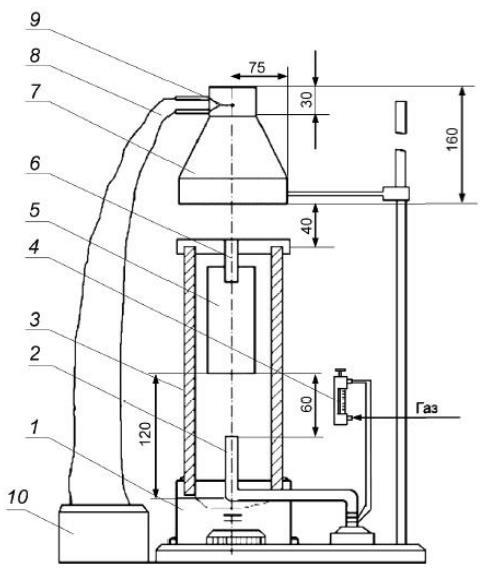
According to the value of the maximum temperature increment ∆tmax (formula 2) and mass loss ∆m (formula 3) materials are classified as:
- low-combustible - ∆tmax<60 0С and ∆m<60 %;
- combustible - ∆tmax≥60 0С or ∆m≥60%.
The maximum temperature increment (∆tmax) is calculated by the formula
∆�� where tmax -themaximum temperatureof gaseous combustionproducts of thematerial under study, 0C; t0 - the starting test temperature (200 0С).
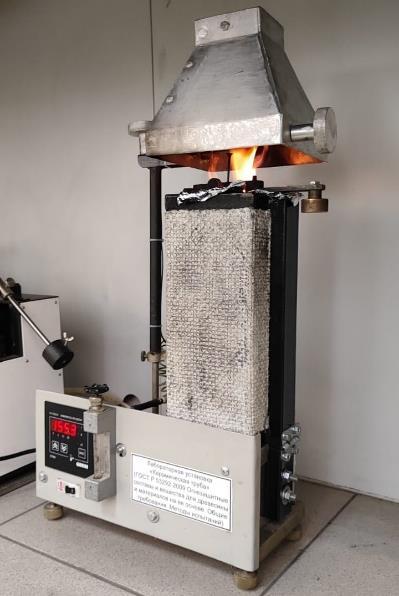
Mass loss ∆m, %, is calculated: where m1 - sample mass before testing, sample mass after testing.
(a)
Statistical processing
(b)
Microsoft Excel 2010 for Windows 8 was used for statistical processing. Each test was repeated three times. The mean value, standard deviation and confidence intervals were calculated. The significance level was 0.05.
Results And Discussion
Thermogravimetric analysis (TGA)
Table 3 shows that for the reference samples of water-impregnated boards at the max temperature tmax 314.94 °C at the thermogravimetric peak the weight loss was 44.4 %. A further temperature increase in the reference samples resulted in the formation of 0.2 % ash residue. The chemical theory explains the properties of fire retardant compositions, such substances change the pyrolysis of wood by increasing charring and formation of less volatile and combustible gaseous products of wood decomposition (Levan et al., 1990). The thermogravimetric analysis results for the fire retardant-impregnated samples are consistent with this theory. It was noted that the pyrolysis of samples occurred at lower temperatures than for the reference samples.
Tab. 3 Intensive decomposition temperatures for the wood board samples impregnated with fire retardants.
The max decomposition temperature (tmax) of the boards impregnated with fire retardant 1 was 85.7 °C lower than that of the reference samples. The weight loss of the samples impregnated with fire retardant 1 at max was 15.1%. The ash residue after the max thermal impact was 60.5 %. Fire retardant 3 showed the highest tmax = 253.97 °C. Upon reaching this temperature, the weight loss was 27.8%. The ash residue was 32.4%, which may indicate a relatively low fire-retardant effect (Uner et al., 2016). The thermal analysis results of the boards impregnated with fire retardant 2 are similar to those of fire retardant 3 (Table 3, Figure 9).
Fire retardant 4 applied to wood boards significantly changes the wood thermal destruction: the rate of destruction decreases, the DTGmax peak shifts to lower temperatures (tmax = 206.28 °C).
Our results are consistent with that presented in (Bezzaponnaya et al., 2017): for efficient fire protection, it is advisable to lower the initial swelling temperature of the flame retardant to reduce the heating rate of the base material. The higher weight loss rate compared to fire retardants 1-4is associated with thefire-retardant decomposition at themax temperature (tmax) resulting in the release of gases that inhibit combustible products of thermal oxidation (Antsupov et al., 2011).
For comparison, Fig. 9 shows the thermo gravimetric and differential thermogravimetric curves (TGandDTG)ofthewoodboardsimpregnated with fireretardant 4 and water.
Fig. 9a shows that thermogravimetric curves of the original low-density board (1) and the fire retardant-impregnated board (5) have different forms. Thermal degradation of the reference boards impregnated with water occurs in three stages, as typical for wood (Sinha et al., 2000). In the first stage (temperature up to 200 oC) the reference boards evaporate the bound moisture and remove the volatile components. Hemicelluloses are decomposed in the second stage (200 to 320 oC). In the third stage, (up to 440oC), cellulose and lignin are degraded. Note that the reference samples at 440 oC had an ash residue of 0.2 %, while for spruce wood this value was about 20 % (Hagen et al., 2009). The difference is probably due to the high porosity of the boards with a higher amount of trapped air. It contributes to a more complete thermal decomposition of wood (Brosse et al., 2010).
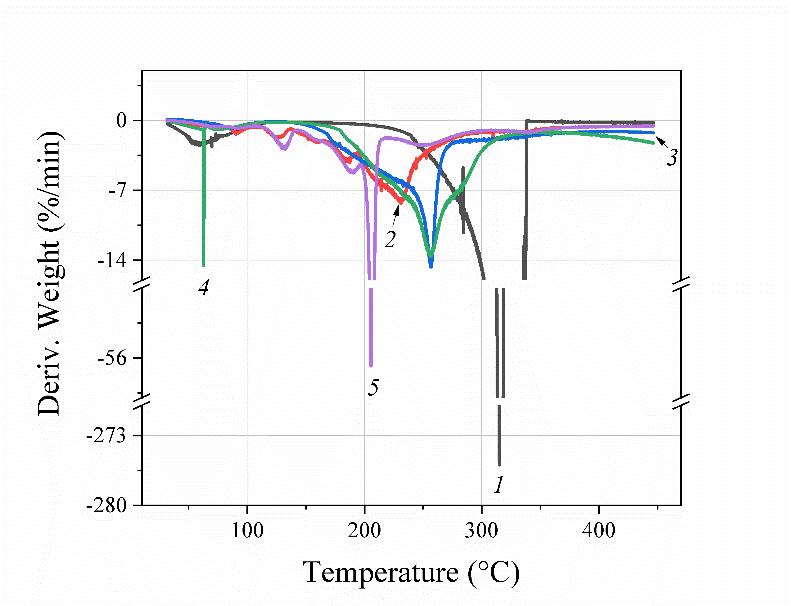
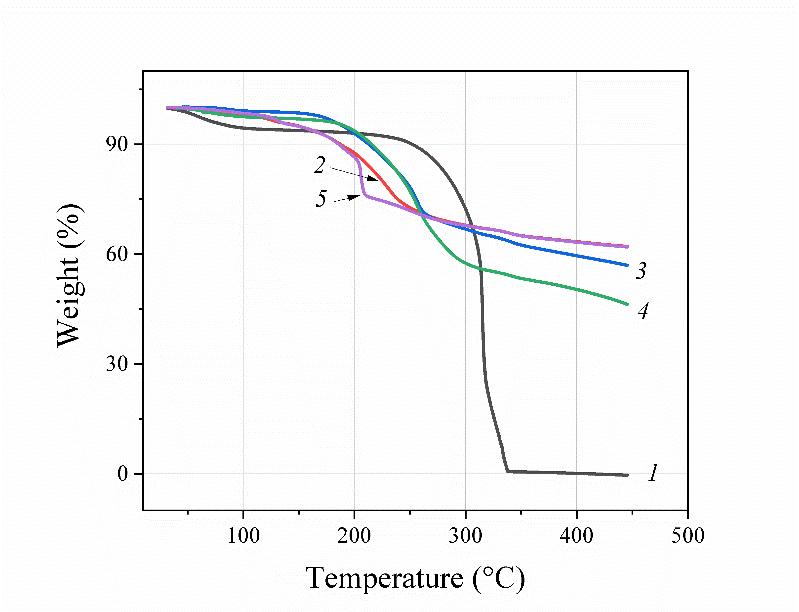
The thermogravimetric curve for the boards impregnated with fire retardant 4 is broadlyconsistentwithpreviousresults(Tang,1967).Theimpregnatedboardsamplesbegan to lose weight at about 50 oC with anintermediate peak at 131 oC, followed by a rapid weight loss increase with a peak at 206.28 oC (Fig.9b). This can be explained by wood dehydration, partial thermal destruction of hemicelluloses, and decomposition of the fire retardant. At a subsequent heating from 215 oC the weight loss slows down. A possible reason is that the thermal decomposition of the fire retardant inhibits the effect of volatile substances released during the decomposition of hemicelluloses. They intensify the cellulose decomposition. It was also found that at about 500 oC the samples of fire retardant-impregnated boards showed a 60 % weight loss.
Therefore, fire retardant 4 was selected to study the binder-free wood board impregnation conditions.
Deep impregnation of wood boards with flame retardants
The results indicate that the absorption of the fire retardant 4 per dry matter ranges from 103.8±1.4 to 288.4±3.1 kg/m3 (Table 4). This is probably due to the large porous volume, where the fire-retardant solution can penetrate and stay.







